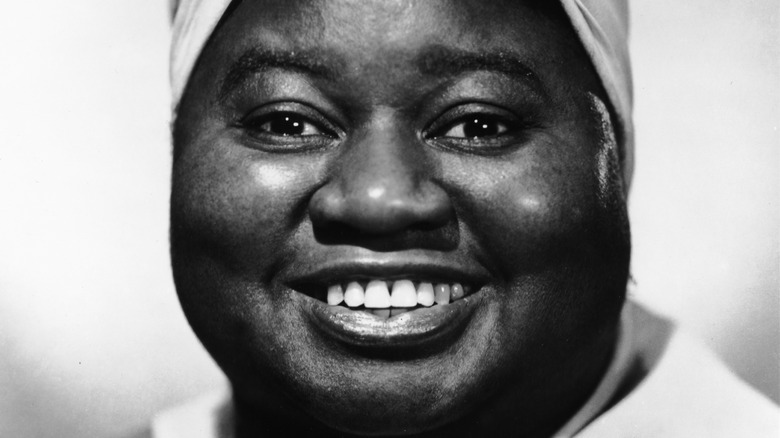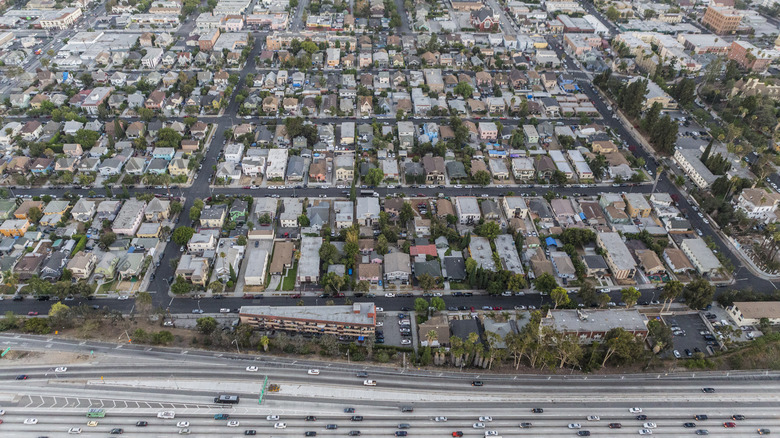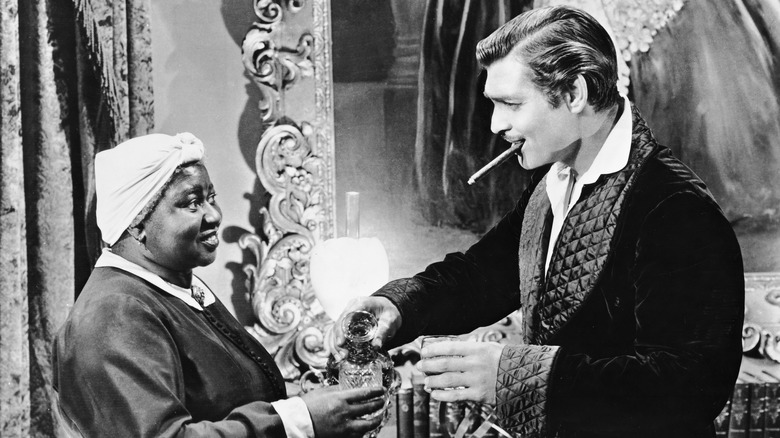How Hattie McDaniel Helped Save An Affluent African American Neighborhood
According to Biography, Hattie McDaniel is best remembered for her Oscar-winning role as Mammy in the 1939 film "Gone With the Wind." In fact, Vanity Fair reports that the actress became the first-ever African American to win an Academy Award for her portrayal of the beloved house servant. Born in 1893, NPR states that her parents were former enslaved people, and the family struggled to stay afloat. McDaniel was a natural performer and saw this as her way out of poverty. She dabbled in comedy before transitioning into singing and, eventually, acting. Despite this, McDaniel was met with blatant racism and intolerance throughout her lifetime.
In 1935, McDaniel starred in "The Little Colonel" as a domestic servant. Britannica explains that this led to several similar roles and a successful career. Nevertheless, McDaniel was heavily criticized by fellow African Americans for portraying stereotypical characters (via Smithsonian Magazine). When she won her Academy Award in 1940, McDaniel believed that she was going to be offered more prominent roles (per The Washington Post).
Instead, her career floundered. This, however, did not prevent McDaniel from living like a Hollywood star. In 1941, the Los Angeles Conservancy states that McDaniel moved into a mansion in the city's Sugar Hill neighborhood. Otherwise known as West Adams Heights, her white neighbors sued to have Sugar Hill's various Black residents evicted (via Curbed Los Angeles). Ever the trailblazer, McDaniel led the legal fight against the discriminatory case and won.
Homeowners were required to sign racially motivated covenants
According to Curbed Los Angeles, West Adams Height was founded in 1902. Prior to its development, the area was a wheat field (via the West Adams Heritage Association). With its expansive streets and elaborate streetlights, the South Los Angeles neighborhood was intended to be an enclave for the city's wealthy white elite. Shortly after, new residents began to build elaborate Victorian and craftsman homes. However, one of the stipulations that homeowners had to adhere to was signing a racially restrictive covenant. As Los Angeles City Planning explains, this document ensured that the neighborhood stayed white. By signing the covenant, homeowners were prohibited from selling or leasing their homes to African Americans and other minorities.
In addition, the West Adams Heritage Association states that the covenant made it necessary for a homeowner to build what was described as a "first-class residence." In other words, the homes were to be large and lavish, with at least two stories and a minimum cost of $2,000. NPR points out that these covenants were not exclusive to just Los Angeles — they occurred everywhere throughout the country.
Author Richard Rothstein defined this and other prejudicial housing programs as a "state-sponsored system of segregation" (per NPR). In Los Angeles specifically, white homeowners banded together to certify that a covenant was being enforced to guarantee a neighborhood's ethnic "purity" (via Los Angeles City Planning).
West Adams transformed from a predominantly white neighborhood into a black community
Curbed Los Angeles explains that between the 1910s and 1920s, West Adams Heights had lost its elite status. Its white residents were heading to other high-society neighborhoods, like Beverly Hills. As for the city's Black residents, covenants had relegated them to Central Avenue, a culturally rich area near Downtown (via a different article from Curbed Los Angeles). However, by the early 1930s, Los Angeles City Planning writes that many of the covenants had expired, and some homeowners decided against renewing them. This was likely due to the Great Depression. Simply put, white homeowners were desperate to sell their homes to whoever wanted to buy them.
According to the West Adams Heritage Association, this resulted in an influx of African Americans in the neighborhood from 1938 to 1945. Overall, NBC Los Angeles states that West Adams became the premier place to live for African American actors and performers. They quickly nicknamed the area Sugar Hill as a nod to a notable Black neighborhood in Harlem, New York, with the same name. Curbed Los Angeles points out that many of these new residents were prominent members of Los Angeles' Black community. They included Norman Houston, the co-founder of Golden State Mutual Life Insurance Company, singer Ethel Waters, and of course, McDaniel.
Hattie McDaniel's Mansion in Sugar Hill
Per the Los Angeles Conservancy, Hattie McDaniel's home was located at 2203 South Harvard Boulevard. Zillow reports that the ornate residence was built in 1911 and features nine bedrooms. Singer Lena Horne later stated (via Curbed Los Angeles) that McDaniel "had the most exquisite house I had ever seen in my life, the best of everything." That being said, McDaniel was known for throwing elaborate parties and hosting salons at her Sugar Hill Mansion. Performers included Duke Ellington, Cab Calloway, and others. As Jill Watts wrote in "Hattie McDaniel: Black Ambition, White Hollywood" (via Curbed Los Angeles), "It was private and intimate, but it was also independent and unfettered, free of white interference."
McDaniel's home was detailed and decorated with her art and book collection. She outfitted the white and green Mediterranean-style property with an air-raid shelter, French furniture, and more. Her beloved Oscar was placed above her fireplace for all to see. Moreover, McDaniel also hosted events that integrated Black and white luminaries. Her "Gone With the Wind" costar, Clark Gable, was a regular at these functions. However, trouble was brewing for McDaniel and her fellow Black neighbors. The Los Angeles Times reports that in 1945, white Sugar Hill residents filed a lawsuit claiming that the property's racial covenants had been violated.
She fought against housing segregation in Los Angeles
In their lawsuit, the Los Angeles Times writes that Sugar Hill's white residents stated that their homes "would lose value and racial clashes would inevitably ensue." Curbed Los Angeles reports that at the time, 57 Black families lived in the area, and they were not going to go down without a fight. McDaniel subsequently began hosting local meetings with her neighbors to battle the lawsuit. The group hired renowned African American lawyer Loren Miller to represent them. In December 1945, McDaniel and 250 supporters walked into the courtroom to witness what came to be known as the Sugar Hill Case (per Vox).
The lawsuit argued that racial covenants were constitutional. That being said, the Supreme Court did not have a clear precedent on the issue. In 1917, they ruled that housing segregation was unconstitutional in Buchanan v. Warley. However, in 1926, they surmised that it was allowed in private contracts in Corrigan v. Buckley. Per Curbed Los Angeles, Miller contended that covenants violated both the California Constitution and the 14th Amendment, which assures that all Citizens have "equal protection of the laws." Ultimately, Judge Thurmond Clarke agreed.
He stated (via Vox), "It is time that members of the Negro race are accorded, without reservations or evasions, the full rights guaranteed them under the 14th Amendment to the Federal Constitution." The West Adams Heritage Association reports that this made Clarke the first judge in the country to use the 14th Amendment against racial covenants.
Little remains of Sugar Hill
With Thurmond Clarke's decision, the Los Angels Times reports that Hattie McDaniel stated (via Vox), "That's one fine judge." Curbed Los Angeles writes that the ruling allowed for Miller to win a similar case, Shelley v. Kraemer, concerning racial covenants in Missouri. According to Oyez, the Supreme Court ruled in 1948 that racial covenants did, in fact, violate the 14th Amendment. This later paved the way for the Fair Housing Act. As for Sugar Hill, the area thrived for a number of years. By 1950, McDaniel had moved out of her mansion and into a smaller home in the area. Per Biography, Hattie McDaniel died on October 26, 1952.
By this point, Curbed Los Angeles reports that several of Sugar Hill's Black residents began to leave. The New York Times states that this was largely due to the fact that the city of Los Angeles was planning to build a freeway through the neighborhood, which would ultimately destroy most of Sugar Hill. Although the area's remaining Black citizens protested the highway, their objections were largely ignored (per NPR). In 1963, the Santa Monica freeway was built, which led to the destruction of several homes owned by Black families. Now, only two blocks and 26 buildings, including McDaniel's mansion, remain of the original Sugar Hill neighborhood (via Historic Places LA).





